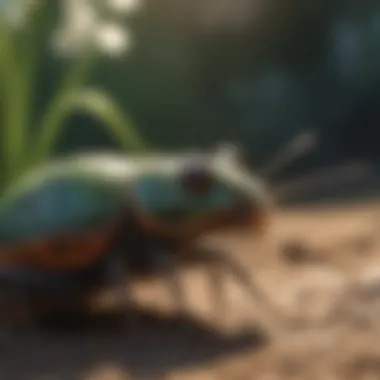Sustainable Pest Control Strategies for Environmental Preservation


Overview of the Topic
When delving into the realm of active environmental pest control, it becomes paramount to understand the intricate balance between managing pests effectively while minimizing adverse environmental impacts. Sustainable practices are the cornerstone of this approach, focusing on harmonizing pest control techniques with the natural environment. This section will provide insights into the significance of adopting eco-friendly pest control measures and the relevance of sustainable practices in conserving biodiversity and ecosystem health.
Current Status and Challenges
The current state of pest control often revolves around conventional methods that rely heavily on chemical pesticides, which can pose significant risks to non-target species and ecosystem health. Challenges facing traditional pest management strategies include the development of pesticide resistance among pests, environmental contamination, and disruptions to ecological balance. In the face of these challenges, the urgent need for adopting sustainable pest control solutions that minimize ecological harm and promote long-term pest management effectiveness becomes apparent.
Sustainable Solutions
Exploring sustainable pest control solutions unveils a plethora of innovative approaches, including integrated pest management (IPM), biological control through natural predators and parasitoids, habitat modification, and cultural practices. These methods emphasize prevention, monitoring, and control strategies that are environmentally sensitive and economically viable. Successful case studies from various regions showcase the efficacy of these sustainable solutions in managing pest populations while preserving ecosystem integrity and safeguarding human health.
Impact and Importance
The impact of environmentally-friendly pest control practices transcends beyond immediate pest management outcomes, influencing the overall health of ecosystems, biodiversity, and human well-being. By reducing the reliance on chemical pesticides and fostering natural pest regulation, sustainable pest control measures contribute to the conservation of beneficial insects, soil health, and water quality. The importance of promoting sustainable pest control practices resonates across ecosystems, benefiting not only current communities but also ensuring a balanced environment for future generations to thrive.
Introduction
The introduction to active environmental pest control sets the stage for understanding the importance of sustainable pest management practices. In this article, we delve into methods that prioritize ecological balance and minimize environmental harm. By shifting away from conventional pest control techniques, we aim to explore how embracing sustainable practices can benefit both ecosystems and human health. The transition to active environmental pest control signifies a crucial shift towards long-term solutions that synergize with nature.
Understanding Pest Control
Definition of Pest Control
The definition of pest control encompasses strategies aimed at managing and eliminating pest populations effectively. In the context of this article, pest control involves employing a range of methods to address pest infestations while considering the impact on the environment. Through targeted interventions, such as biological control and organic pest control, this approach focuses on minimizing reliance on harmful chemicals, promoting biodiversity, and fostering sustainable pest management practices.
Importance of Environmental Considerations
The importance of environmental considerations in pest control cannot be overstated. By prioritizing ecological factors, we can implement pest management strategies that minimize harm to non-target species and reduce chemical pollution. Integrating environmental considerations into pest control practices not only safeguards ecosystems but also contributes to the long-term sustainability of agricultural and urban environments.
Challenges in Conventional Pest Control
Chemical Pollution
Chemical pollution resulting from conventional pest control methods presents a significant challenge to environmental health. The reliance on synthetic pesticides can lead to water and soil contamination, endangering non-target organisms and disrupting ecosystems. Mitigating chemical pollution through the adoption of sustainable pest control practices is imperative to reduce ecological harm and preserve biodiversity.
Harm to Non-Target Species


The unintended consequences of conventional pest control, such as harm to non-target species, underscore the need for more targeted and environmentally conscious approaches. By inadvertently affecting beneficial insects, birds, and wildlife, traditional pest management practices can disrupt ecosystem dynamics. Transitioning to sustainable pest control methods mitigates these risks and allows for more harmonious coexistence within ecosystems.
Transition to Sustainable Practices
Rise of Active Environmental Pest Control
The rise of active environmental pest control marks a paradigm shift in pest management towards more sustainable and eco-friendly approaches. With a focus on integrated pest management and natural predators, this evolution acknowledges the interconnectedness of species and ecosystems. By harnessing nature's mechanisms for pest regulation, active environmental pest control offers effective and long-lasting solutions that align with ecological principles.
Benefits of Sustainable Pest Control
Embracing sustainable pest control practices yields a multitude of benefits for both the environment and human well-being. From safeguarding pollinators to reducing pesticide residues in food, sustainable pest management contributes to ecosystem resilience and public health. By promoting biodiversity, soil health, and water quality, sustainable practices offer a holistic approach to pest control that aligns with ecological sustainability.
Integrated Pest Management (IPM)
Integrated Pest Management (IPM) is a crucial aspect of sustainable pest control discussed extensively in this article. IPM entails a holistic approach to pest management, emphasizing the prevention, monitoring, and control of pests through environmentally friendly practices. By integrating various strategies, IPM aims to reduce reliance on chemical pesticides while effectively managing pest populations in an eco-conscious manner.
Principles of IPM
Prevention
Prevention plays a pivotal role in IPM by focusing on measures to prevent pest infestations before they occur. Notably, prevention emphasizes the importance of cultural practices, such as proper sanitation and maintenance, to create unfavourable conditions for pests. By addressing potential entry points and removing attractants, prevention acts as a proactive measure to deter pests naturally. Its unique feature lies in its ability to disrupt pest life cycles without resorting to harmful chemicals, promoting long-term pest management sustainability while minimizing environmental impact.
Monitoring
Monitoring is a fundamental component of IPM that involves regular assessments of pest populations and their impact on the ecosystem. Through routine inspections and data collection, monitoring helps to detect pest outbreaks early, enabling timely intervention. The key characteristic of monitoring is its ability to provide valuable insights into pest behaviour, population dynamics, and susceptibility to control measures. By offering real-time information, monitoring enhances decision-making processes, ensuring targeted and effective pest management strategies.
Control
Control within IPM encompasses the implementation of pest control measures based on scientific assessments and integrated approaches. It involves the careful selection of control tactics, considering factors such as pest biology, environmental impact, and efficacy. The key characteristic of control is its adaptability, allowing for the customization of strategies according to specific pest pressures and ecological conditions. Despite some inherent challenges, such as the potential for pest resistance and regulatory limitations, control remains a pivotal element in achieving sustainable pest management outcomes.
Natural Predators in Pest Control
In the realm of active environmental pest control, the utilization of natural predators plays a pivotal role. These organisms act as a biological defense system against pests, contributing to a more sustainable approach to pest management. By incorporating natural predators into pest control strategies, a delicate ecological balance can be maintained, reducing the reliance on harmful chemicals and promoting a harmonious coexistence between species.
Role of Natural Predators
Ladybugs


Ladybugs, also known as ladybirds, are esteemed for their voracious appetite for aphids and other detrimental insects. Their vibrant appearance not only adds a splash of color to gardens but also serves as a natural pest control mechanism. Ladybugs are a valuable asset in combating pest infestations, making them a popular choice for organic farming practices. Their adaptability to diverse environments and rapid reproduction rate make them efficient allies in pest management. Yet, over-reliance on ladybugs may lead to an imbalance in predator-prey dynamics, mandating a careful integration strategy.
Praying Mantises
Praying mantises are revered for their predatory prowess, targeting a wide range of pests including moths, mosquitoes, and even small vertebrates. Their camouflaging abilities and stealthy hunting techniques make them formidable hunters in the realm of pest control. Praying mantises are utilized in agricultural settings to mitigate pest populations naturally. However, while effective, they can inadvertently prey on beneficial insects as well, necessitating a cautious approach to their deployment.
Birds of Prey
Birds of prey, such as hawks and owls, act as formidable predators in pest control by preying on rodents and insects that plague agricultural lands. Their keen eyesight and sharp talons enable them to maintain a balance in ecosystems by controlling pest populations. Implementing practices to attract and support bird habitats can significantly reduce the need for chemical interventions. While birds of prey offer valuable pest control services, their widespread usage for this purpose requires meticulous monitoring to prevent disruptions to local wildlife populations.
Encouraging Predator Habitats
Native Plantings
Integrating native plant species into ecosystems can provide a rich resource base for natural predators, thereby enhancing their presence and effectiveness in pest control. Native plantings offer a familiar environment for predators, ensuring their continued presence for pest management. Additionally, native plants support biodiversity and ecosystem resilience, contributing to sustainable pest control practices. Careful selection of plant species based on the habitat requirements of specific predators enhances the overall efficacy of this integrated approach.
Diverse Ecosystems
The promotion of diverse ecosystems through the incorporation of varied habitats and vegetation types fosters a robust predator community. Diverse ecosystems offer a myriad of niches for different predators to thrive, creating a finely balanced ecosystem. By encouraging biodiversity through the provision of diverse habitats, the natural regulation of pest populations is amplified. However, maintaining ecosystem diversity requires careful planning and management to prevent the dominance of certain predator species over others, ensuring a holistic approach to sustainable pest control.
Organic Pest Control Methods
Organic pest control methods play a pivotal role in promoting sustainable practices in pest management. In this section, we will delve into the significance of incorporating organic methods in active environmental pest control. Organic pest control focuses on utilizing natural products and techniques to address pest infestations without causing harm to the environment or human health. By eschewing synthetic chemicals and promoting holistic approaches to pest management, organic methods offer a safe and effective alternative to conventional pest control strategies.
Introduction to Organic Pest Control
Benefits of Organic Methods:
The benefits of organic pest control methods are abundant and diverse. One key advantage is the absence of harmful residues in the environment, ensuring the health and well-being of not only humans but also other living organisms. Organic methods are biodegradable and do not persist in the ecosystem, thereby reducing long-term environmental impact. Additionally, organic pest control promotes biodiversity by preserving beneficial insects and microorganisms that play a vital role in natural pest regulation, contributing to a balanced ecosystem.
Avoiding Harmful Chemicals:
Avoiding harmful chemicals is a core principle of organic pest control methods. By refraining from the use of synthetic pesticides and other toxic substances, organic practices safeguard soil quality, water resources, and overall environmental health. This avoidance of harmful chemicals also protects pollinators such as bees and other beneficial organisms essential for ecosystem functioning, thereby promoting a sustainable and resilient environment.
Popular Organic Pest Control Strategies
Neem Oil:


Neem oil is a prevalent organic pest control solution known for its multifaceted benefits. Derived from the seeds of the neem tree, this natural product acts as a potent insect repellent while also disrupting the life cycle of various pests. Neem oil is environmentally friendly, targeting pests effectively without harming beneficial insects or pollinators. Its systemic properties make it a preferred choice for organic farmers and gardeners seeking sustainable pest management alternatives.
Diatomaceous Earth:
Diatomaceous earth is a versatile and environmentally safe substance widely used in organic pest control strategies. Composed of fossilized diatoms, this powdery substance abrades the exoskeleton of insects, leading to dehydration and eventual death. Diatomaceous earth is effective against a broad spectrum of pests, including ants, cockroaches, and beetles, making it a popular choice for controlling infestations indoors and outdoors. Its non-toxic nature and long-lasting impact add to its appeal for eco-conscious pest management.
Garlic Spray:
Garlic spray is a natural and potent organic insecticide that repels pests through its strong odor and insecticidal properties. Made from garlic cloves steeped in water and blended into a liquid solution, garlic spray is effective against a wide array of pests such as aphids, caterpillars, and beetles. This organic pest control method is safe for plants, animals, and the environment, offering a sustainable and chemical-free alternative for pest management.
Biological Pest Control Measures
Biological pest control measures play a pivotal role in active environmental pest control practices. This section focuses on incorporating natural mechanisms and living organisms to manage pest populations effectively while minimizing environmental impact. By utilizing biological agents, such as beneficial microorganisms and nematodes, along with biopesticides like botanical extracts and microbial inoculants, a holistic approach to pest management is achieved.
Utilizing Biological Agents
When it comes to utilizing biological agents for pest control, beneficial microorganisms stand out as key players in promoting sustainable practices. Beneficial microorganisms are naturally occurring microorganisms that help in controlling pests by competing with harmful organisms or directly attacking them. These microorganisms enhance soil health, improve plant growth, and suppress pest populations, making them an essential component of biological pest control measures.
Beneficial microorganisms exhibit unique characteristics such as versatility, adaptability, and eco-friendliness. They are known for their ability to establish long-lasting relationships with plants, promoting symbiotic interactions that lead to better pest resistance and overall ecosystem health. Their non-toxic nature makes them a safe alternative to synthetic pesticides, ensuring minimal harm to the environment and beneficial insects. However, the effectiveness of beneficial microorganisms may vary depending on environmental conditions and application methods.
Nematodes, another crucial biological agent, are microscopic roundworms widely used in pest management strategies. Nematodes prey on various insect pests, effectively reducing their populations and protecting plants from damage. They target specific pests without harming beneficial insects, making them a selective and eco-friendly option for pest control. Nematodes possess the unique ability to seek out hosts within the soil, making them efficient predators in underground ecosystems.
Application of Biopesticides
In the realm of biological pest control measures, biopesticides like botanical extracts and microbial inoculants offer sustainable alternatives to chemical insecticides. Botanical extracts derived from plants contain bioactive compounds that repel or harm pests while being safe for the environment and non-target organisms. These extracts are biodegradable and pose minimal risk to human health, aligning with the principles of eco-conscious pest management.
Botanical extracts possess key characteristics such as biocompatibility, efficacy, and low persistence in the environment. Their plant-based origin makes them highly versatile and suitable for organic farming practices. However, the efficacy of botanical extracts can be influenced by factors like application timing, concentration, and pest susceptibility, necessitating precise implementation for optimal results.
Microbial inoculants, on the other hand, consist of beneficial microorganisms formulated into products for targeted pest control. These inoculants contain specific strains of bacteria or fungi that actively combat pest infestations while promoting plant growth and soil health. Microbial inoculants offer a sustainable solution to pest management by harnessing the power of beneficial microorganisms in a convenient and environmentally friendly form.
Microbial inoculants exhibit unique features such as strain specificity, compatibility with diverse cropping systems, and safety for humans and animals. Their application provides a natural and non-disruptive approach to pest control, supporting biological diversity and soil sustainability. However, like any biopesticide, the efficacy of microbial inoculants may vary based on environmental factors, target pests, and application practices.
Conclusion
Active Environmental Pest Control is a pivotal aspect of sustainable pest management. By exploring eco-friendly methods such as integrated pest management, organic pest control, and biological pest control, individuals and communities can effectively address pest issues while safeguarding the environment. This article serves as a comprehensive guide, shedding light on the importance of implementing active environmental pest control practices in today's world.
Embracing Active Environmental Pest Control
Sustainable Solutions for Pest Management
Sustainable Solutions for Pest Management play a crucial role in promoting environmentally friendly pest control. These solutions involve utilizing natural and organic methods to combat pests, reducing the reliance on harmful chemicals and pesticides. By emphasizing prevention and eco-conscious practices, Sustainable Solutions for Pest Management help maintain ecological balance while effectively managing pest populations. Their key characteristic lies in their ability to provide long-term solutions without causing harm to the environment. This approach is beneficial for both the ecosystem and human health as it minimizes chemical exposure and encourages natural pest control methods. A unique feature of Sustainable Solutions for Pest Management is their holistic approach, which considers the broader impact of pest control measures on the environment and biodiversity. While their advantages include sustainable pest management and reduced environmental impact, some disadvantages may include the need for consistent monitoring and potential initial costs.
Promoting Ecological Balance
Promoting Ecological Balance is essential for fostering a harmonious relationship between pests, natural predators, and the environment. This aspect focuses on enhancing biodiversity, creating habitats for beneficial insects, and maintaining a sustainable ecosystem. By promoting Ecological Balance, individuals contribute to the overall health of the environment and reduce the reliance on chemical interventions for pest control. The key characteristic of Promoting Ecological Balance lies in its emphasis on coexisting with pests rather than eradicating them, recognizing their role in the ecosystem. This popular choice in pest management aligns with the principles of conservation and sustainability, prioritizing natural solutions over chemical treatments. A unique feature of Promoting Ecological Balance is its ability to create resilient ecosystems that can self-regulate pest populations over time. Its advantages include reduced environmental impact, improved biodiversity, and long-term ecological benefits. However, challenges may arise in maintaining balance within complex ecosystems and adapting to changing environmental conditions.



